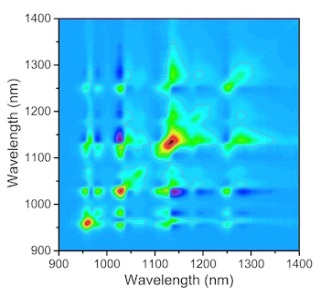A innovative technique, where rapid spectral snapshots of tiny areas of dilute nanotube solution are recorded, has been used by researchers at Rice University to determine the characteristics of the nanotubes in the solution.
 A covariance matrix produced with a new technique at Rice University maps fluorescence signals from various species of single-walled carbon nanotubes that are beginning to aggregate in a sample. The matrix allows researchers to know which types of nanotubes (identified by their fluorescence spectra) have aggregated and in what amounts, in this case after four hours in solution. (Credit: Weisman Lab/Rice University)
A covariance matrix produced with a new technique at Rice University maps fluorescence signals from various species of single-walled carbon nanotubes that are beginning to aggregate in a sample. The matrix allows researchers to know which types of nanotubes (identified by their fluorescence spectra) have aggregated and in what amounts, in this case after four hours in solution. (Credit: Weisman Lab/Rice University)
Using the spectral snapshots the composition of nanotubes was studied by comparing the similarities and differences between thousands of different snapshots. This gave the team enough new data regarding the properties and types of nanoparticles present in the solution.
The new method has been illustrated in an open-access paper in the September issue of Journal of Physical Chemistry Letters of the American Chemical Society.
Bruce Weisman, Rice chemist and a pioneer in the spectroscopy field, believes that variance spectroscopy will be an asset to researchers keen on pursuing research on nanoscale materials. He was the leader of the work that discovered and interpreted near-infrared fluorescence from semiconducting carbon nanotubes.
Carbon nanotubes can be defined as hollow cylinders of pure carbon, which are generally grown in a furnace. There are many types of nanotubes with a large variation in their physical properties meaning their probable applications differ widely. It is not feasible to grow just one type of nanotube so they must be categorized by chemical or physical methods.
Weisman recommends the usage of variance spectroscopy for this purpose. Variance spectroscopy can be used to assist in the sorting and separation of different nanotube types for optical and electronic applications.
The Weisman lab tested its custom rig on dispersed samples of single-wall carbon nanotubes. Fluorescence spectra were captured by the team from thousands of distinct small areas. Additionally, the tests revealed the statistical variations in the spectra, which in turn exposed the different types of nanotubes by the strength with which each nanotube could emit light.
Further analysis of the data provided the “dissected” spectra of each nanotube type, without the interference of other nanotubes in the assorted sample.
As we focus our attention on smaller and smaller volumes of the sample, the averaged-out, uniform behavior you see on the macroscopic scale starts to break down, and we see effects from the particulate nature of matter. At that point, there are random fluctuations in the numbers of particles within the observed volume. What we’re doing is analyzing the resulting random fluctuations in spectra to learn about how many particles of each type are present and whether they’re aggregated with each other. An analogy might be looking at fans in a football stadium wearing their teams’ colors. If you stand way back and look at the whole crowd, all you can figure out is the overall ratio of Rice fans to Texas fans. But if you zoom in and analyze row by row, you’re going to see clusters of Rice fans and clusters of Texas fans and learn how each group aggregates together. That gives you extra insights about the crowd that you could never get from the big view. It’s similar with nanotubes. We look at a sample that has a variety of structures and learn more about the properties of individual components. It’s a spectroscopic dissection of a complex mixture to get information that would be much more difficult to get with any other method.
- Bruce Weisman, Rice
Additionally, Weisman stated that the method offers solutions to the problem of nanotubes clumping together.
When you’re trying to use a separation method to sort them out, you can’t do it effectively if they’re stuck together. If you want type A and they’re stuck to type B, then you’re wasting your separation effort. But variance spectroscopy provides a very sensitive way to tell whether particles of different types are actually traveling together.
- Bruce Weisman, Rice
Weisman anticipates that variance spectroscopy can be applied even to test many nanoscale materials, such as quantum dots and gold nanoparticles, with the aid of a variety of spectroscopic probes.
When you make nanomaterials, there is generally some variation in particle sizes that gives a corresponding variation in the spectral properties. Our variance method can be used with such systems to take a look inside.
- Bruce Weisman, Rice
The research was supported by the National Science Foundation and the Welch Foundation.